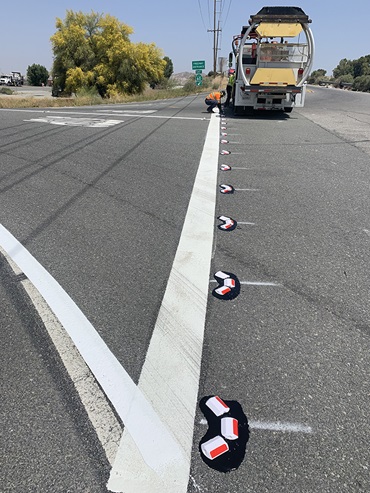Statewide pilot models quick safety improvements

Roadways enhanced with more warning signs, crosswalks, other features

Thousands of California off-ramps, intersections, and highways will see safety enhancements sooner thanks to an innovative effort that is expediting safety projects across the state.
The HM-4 Safety Pilot Program (“HM” short for highway maintenance), the result of a collaboration among Caltrans’ districts, the Maintenance Division, and the Division of Safety Programs, was launched in 2021 to deliver cost-effective safety projects through Highway Maintenance. The first fiscal year of the two-year program ended in June 2022.
So far, the program has expedited funding for horizontal curve warning sign packages, crosswalk enhancements, and wrong-way driver prevention countermeasures at about 4,500 spot locations statewide.
“This program allows us to quickly initiate and complete enhancements that are lower cost but highly effective in terms of saving lives,” Chief Safety Officer Rachel Carpenter said. “This is a great example of a proactive, collaborative program that is helping Caltrans to achieve our goal of zero fatal and serious injury crashes on our system.”
Background
In July 2021, the HM-4 Safety Pilot Program was approved with a budget of $21.6 million per year. The Division of Maintenance manages this program in collaboration with the Division of Safety Programs.
The program created a funding source to quickly implement Proven Safety Countermeasures (PSCs) through the HM Program delivery cycle. It funds capital costs for stand-alone projects in three areas: Wrong-Way Driver Prevention Countermeasures, Horizontal Alignment Curve Warning Sign Packages, and Pedestrian Safety Improvements. The last area is critical as a disproportionate percentage of fatal crashes involve pedestrians (about 20 percent on the State Highway System, and about 30 percent on local streets and roads).
HM projects tend to be shorter-lead, quick-build projects with limited right of way or permitting delays, so they can be programmed and constructed much faster than traditional project development methods. Safety enhancements developed through the HM programs generally can be installed within a year or two; these same improvements would otherwise be stand-alone safety capital projects, or part of other capital projects that can take several years to initiate.
To develop and manage this program, Caltrans created limited-term positions in Headquarters Safety Programs and Maintenance Divisions. The program coordinators reached out to all districts for project nominations in the three focus areas. Headquarters and district project engineers and pedestrian coordinators reviewed and prioritized the project nominations to finalize work plans.
Maintenance added selected projects to its HM Contract for Delivery for the participating districts. The Maintenance Division tracks delivery and completion of each approved project. Safety Programs is tracking and documenting the performance measures (spot location quantities) for each approved project.
Results
In the first two fiscal years, the pilot funded safety enhancement installations in the three focus areas at 4,455 locations. That number exceeded the program’s 2-year targets by more than 1,200 locations.
The below table summarizes the results so far:

Many of the projects funded by the program have already been completed. For example, a wrong-way driver prevention countermeasure including LED bordered wrong-way signs on Interstate 8 in District 11, and red retroreflective wrong-way markers on Interstate 60 in District 8 (see the accompanying photographs).
Next steps
Because of the success of the pilot, Caltrans is proposing to continue the program and expand to other focus areas.
The program also is an example of Caltrans’ Safe Systems Approach, which is based on six key principles that define how we respond to safety challenges, implement interventions, and evaluate progress.
By accounting and planning for human error, and by taking proactive steps to protect all roadway users the HM-4 Safety Pilot Program serves as a model of how Caltrans can implement this policy across the Department.
Most importantly, the program is one way for Caltrans to double down on measures that we know are effective in saving lives.
“Thank you to staff at Headquarters and in the districts who are working to implement this program,” Maintenance Division Chief Sergio Aceves said. “Safety is the top priority for Caltrans. This program allows us to make quick, effective fixes to protect the traveling public, especially vulnerable road users, and ensure that everyone reaches their destinations safely and efficiently.”
Sources: Koko Widyatmoko, HM-4 Safety Program coordinator; and Alex Katz, deputy division chief, Communications & Strategic Delivery, Division of Safety Programs

